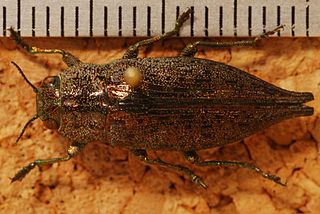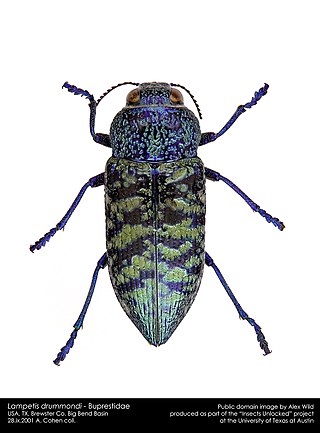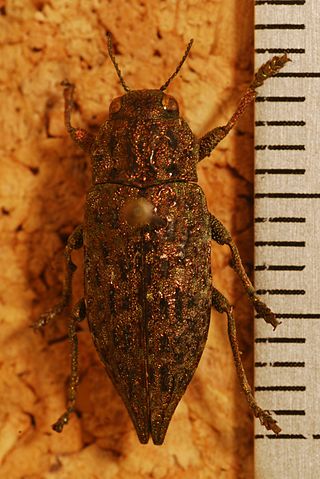
Buprestidae is a family of beetles known as jewel beetles or metallic wood-boring beetles because of their glossy iridescent colors. Larvae of this family are known as flatheaded borers. The family is among the largest of the beetles, with some 15,500 species known in 775 genera. In addition, almost 100 fossil species have been described.

Dicerca is a genus of beetles in the family Buprestidae. It contains the following species:
The Pacific shortfinned eel, also known as the Pacific shortfinned freshwater eel, the short-finned eel, and the South Pacific eel, is an eel in the family Anguillidae. It was described by Albert Günther in 1871. It is a tropical, freshwater eel which is known from western New Guinea, Queensland, Australia, the Society Islands, and possibly South Africa. The eels spend most of their lives in freshwater, but migrate to the Pacific Ocean to breed. Males can reach a maximum total length of 110 centimetres, but more commonly reach a TL of around 60 cm. The Pacific shortfinned eel is most similar to Anguilla australis, and Anguilla bicolor, but can be distinguished by the number of vertebrae.

Dicerca moesta is a species of beetle from Argante subgenus which can be found everywhere in Europe.

Dicerca divaricata, also known as the flatheaded hardwood borer, is a species of black coloured beetle from subfamily Chrysochroinae found in North America. It is 15–22 millimetres (0.59–0.87 in) long. The species is known for feeding on various maples such as Acer saccharum and Acer rubrum as well as Ulmus americana and Cercis species. The species fly in May and June.
Dicerca pugionata, also known as the witch-hazel borer, is a species of buprestid beetle from the Chrysochroinae subfamily that occurs in the Eastern North America. Its food includes witch-hazel species including Hamamelis virginiana in mid July. It also feeds on ninebark and alder species.
Dicerca lugubris is a species of beetle from the subfamily Chrysochroinae first described by John Lawrence LeConte in 1860. It is dark-cupreous coloured on top and black-cupreous below. The length of the species may vary from 11.1–16.5 millimetres (0.44–0.65 in) while they can be as wide as 4.1–6.0 millimetres (0.16–0.24 in). The species can be found on Lake Superior, Marquette, Michigan as well as Laniel, Quebec. It is also found in Iowa, Alberta, and southeastern North America where it feeds on jack pine.
Dicerca tenebrica, the flatheaded wood borer or flatheaded poplar borer, is a brassy to black coloured beetle from Chrysochroinae subfamily which can be found in Canada and both Southern and Northeastern United States. The species was first described by William Kirby in 1837.

Drosophila subobscura is a species of fruit fly in the family Drosophilidae. Originally found around the Mediterranean, it has spread to most of Europe and the Near East. It has been introduced into the west coasts of Canada, the United States, and Chile. Its closest relative is Drosophila madeirensis, found in the Madeira Islands, followed by D. guanche, found in the Canary Islands. These three species form the D. subobscura species subgroup. When they mate, males and females perform an elaborate courtship dance, in which the female can either turn away to end the mating ritual, or stick out her proboscis in response to the male's, allowing copulation to proceed. D. subobscura has been regarded as a model organism for its use in evolutionary-biological studies.

Dicercina is a subtribe of metallic wood-boring beetles in the family Buprestidae. There are at least 2 genera and 20 described species in Dicercina.
Dicerca juncea is a species of metallic wood-boring beetle in the family Buprestidae. It is endemic to the Southeastern United States, with the type material from the Florida, Alabama, and Georgia. It is an elongate beetle of about 14.2 mm (0.56 in) length.
Dicerca spreta is a species of metallic wood-boring beetle in the family Buprestidae. It is endemic to the eastern United States.
Dicerca punctulata is a species of metallic wood-boring beetle in the family Buprestidae. It is found in North America.
Dicerca caudata is a species of metallic wood-boring beetle in the family Buprestidae. It is found in North America.
Dicerca tuberculata is a species of metallic wood-boring beetle in the family Buprestidae. It is found in North America.
Dicerca hornii is a species of metallic wood-boring beetle in the family Buprestidae. It is found in North America.
Dicerca callosa is a species of metallic wood-boring beetle in the family Buprestidae. It is found in North America.

Dicerca tenebrosa, the flatheaded conifer borer, is a species of metallic wood-boring beetle in the family Buprestidae. It is found in North America.
Dicerca asperata is a species of metallic wood-boring beetle in the family Buprestidae. It is found in North America.
Dicerca crassicollis is a species of metallic wood-boring beetle in the family Buprestidae. It is found in North America.







